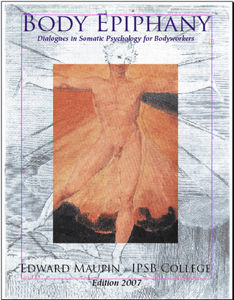| HOME | BOOKS | PAPERS | LINKS | PHOTOS | PHOTOS 2 | PERSONAL |
|
Dialogue materials for Somatic Psychology (Maupin, revised 2007)
Download for free: epiphany.pdf [21 MB]
|
ContentsPart I: Somatics Introduction to the Somatic Viewpoint I-1 A Partial History of Somatics in the West I-2 The Body Epiphany is the Beginning of Somatics I-4 What Makes Something Somatic? I-6 Five Elements of Somatics I-8 Somatics Today I-10 Part II: Somatic Bodywork Basic Awareness Techniques II-2 Awareness-Oriented Bodywork II-4 The Focus is on Communication II-5 "Touching to Know" II-6 The Client's Four Steps of Participation II-8 Is Pleasure a Problem? II-10 Imagery for Deep Tissue Touch II-11 Assumptions of Somatic Bodywork II-12 Assumptions about Energy II-14 Touch and Energy II-16 the Energetics of Bodywork II-18 Skinrolling II-20 Part III: Somatic Topics The Mind (Soul) and the Body III-2 Sensation, Perception, and Consciousness III-4 Relationship with the Unconscious III-6 "The Creature" III-8 Somatic Maps III-10 Three Centers Maps III-12-15 Inner-Outer Maps III-16 Central Axis Maps III-18 Meridians, Cabbalah III-20 Memory in the Body III-22 Traumatic Memory: Levine's Theory III-23 Fear and Contraction III-24 Shame III-26 Somato-Sensory Affectional Deprivation III-28 Questioning the Historical Hypothesis III-29 Body Alienation III-30 The Psychoanalytic Lineage Freud III-32 Reich III-34 Bioenergetics III-36 Object Relations Theory III-38 Self Psychology III-40 The Body Politic III-42 More About the Senses III-44 Six Sensory Surfaces III-46 Four Basic Actions III-47 Mapping the Levels of Touch III-48 Sensory Balance III-50 What's Missing in this Book? III-52 Selected Bibliography III-53 |
